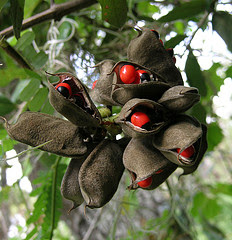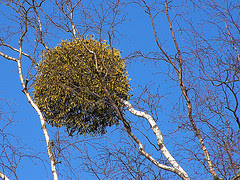Toxalbumins - Peas and beans gone bad
Toxalbumins are protein phytotoxins (toxins produced by plants) capable of inhibiting protein synthesis, which is kind of a really bad thing to have happen to you. They are technically a type of ribosome-inactivating protein (RIP, a most suitable acronym), but more on that later.
 Abrin is a toxalbumin made by Abrus precatorius (Rosary Pea, Crab's Eyes, Jequirity), a vine that produces pea-sized bright red with a black splotch seeds that are used as beads and to make rattles. These seeds, although chock full of abrin, have a hard water-resistant coat, meaning that if you ingest them they are only toxic if they are chewed or broken.
Abrin is a toxalbumin made by Abrus precatorius (Rosary Pea, Crab's Eyes, Jequirity), a vine that produces pea-sized bright red with a black splotch seeds that are used as beads and to make rattles. These seeds, although chock full of abrin, have a hard water-resistant coat, meaning that if you ingest them they are only toxic if they are chewed or broken.
 Ricin is a toxalbumin present in the seeds (beans, although not true beans) and other parts of Ricinus communis (Castor Bean). It is by far one of the easiest chemical warfare agents to obtain, since the plant grows all over the place (it's a common weed in North America) and the extraction of the toxin is relatively simple.
Ricin is a toxalbumin present in the seeds (beans, although not true beans) and other parts of Ricinus communis (Castor Bean). It is by far one of the easiest chemical warfare agents to obtain, since the plant grows all over the place (it's a common weed in North America) and the extraction of the toxin is relatively simple.
 Viscumin and phoratoxin are toxalbumins produced by species belonging to the genera Viscum and Phoradendron, respectively. Both are mistletoes, those wonderful Christmas plants that enable public displays of affection and parasitize trees. Apparently mistletoe evolved independently five times, meaning that there are five different families of it. Viscum album (European mistletoe) is featured in Greek and Celtic mythologies and was the original Christmastime decoration, while Phoradendron serotinum (Eastern Mistletoe) is the main species grown and used by those in North America during the season of giving.
Viscumin and phoratoxin are toxalbumins produced by species belonging to the genera Viscum and Phoradendron, respectively. Both are mistletoes, those wonderful Christmas plants that enable public displays of affection and parasitize trees. Apparently mistletoe evolved independently five times, meaning that there are five different families of it. Viscum album (European mistletoe) is featured in Greek and Celtic mythologies and was the original Christmastime decoration, while Phoradendron serotinum (Eastern Mistletoe) is the main species grown and used by those in North America during the season of giving.
Other toxalbumins include: crepitin (aka hurin), found in the seeds of Hura crepitans (Sandbox tree), a tropical evergreen tree that produces numerous pointed spines on its trunk and pumpkin-like fruits that explode with considerable kaboom on drying; curcin (aka jatrophin), found in the seeds of species of the genus Jatropha, a New World shrub; momordin, found in the seeds and outer rind of the fruit produced by species of the genus Momordica; and robin and phasin, present in the bark, leaves, and seeds of Robinia pseudoacacia (Black Locust), a tree native to the United States with pretty little white flowers.
As I mentioned previously, toxalbumins are toxic because they inhibit protein synthesis. They accomplish this in a neat way. Each one is a dimer made up of two subunits, simply designated A and B. To spice things up, I will refer to them Albert and Betty. Albert is the actual toxin, while Betty is a lectin (carbohydrate-binding protein) that helps get him inside cells by binding to the cell membrane. Many plants produce Albert, but without Betty, he's just a harmless old fart. Once inside a cell, Albert is able to selectively catalyze the cleavage of an N-glycosidic bond in the 28S ribosomal RNA that is a crucial part of eukaryotic ribosomes, the things inside cells that make proteins, thus inhibiting their formation and essentially shutting down the cell. A single molecule of one of these toxalbumins is capable of inactivating thousands of ribosomes. Ribo oh no! Since people are generally exposed to these things via ingestion, their first site of action tends to be the rapidly proliferating cells of the intestinal wall.
Poisoning proceeds as follows. First there is a latent period, in which nothing appears to be happening. In actuality, the toxin is hard at work, shutting down ribosomes. Then things start to happen. Time to get out your catastrophic health insurance card and head to the hospital. A little nausea, some vomiting and diarrhea. Some victims develop ulcerative lesions throughout their GI tract. The gastric mucosa starts to hemorrhage. Total disruption of intestinal function leads to massive fluid and electrolyte loss, and death soon follows.
- Lampe KF and McCann MA. AMA Handbook of Poisonous and Injurious Plants. American Medical Association, Chicago, 1985.
- Hui A, Marraffa JM, Stork CM. A rare ingestion of the Black Locust tree. J Toxicol Clin Toxicol. 2004;42(1):93-5.
- The pretty pictures were taken by deadmike, M Kuhn, and Randy Read.






